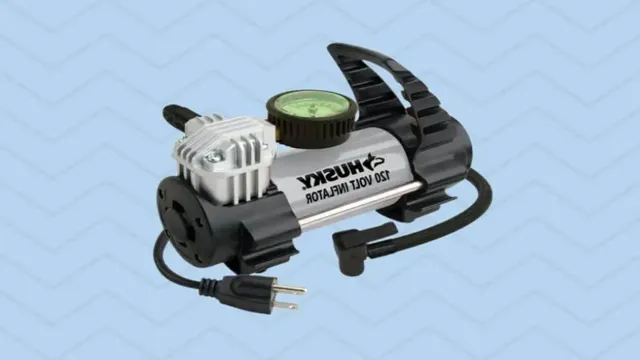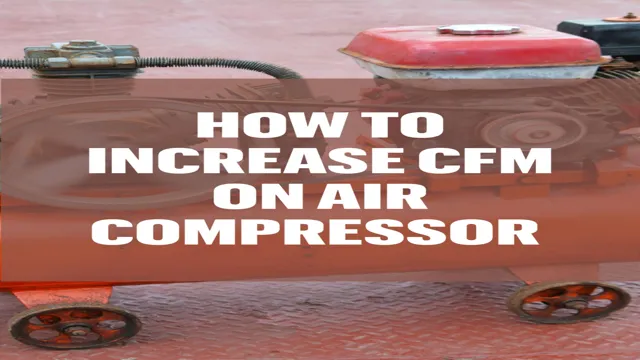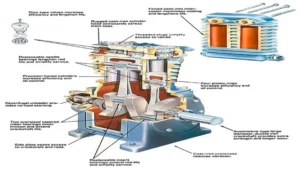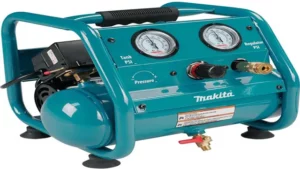Air compressors are one of the most common and essential tools in the world of manufacturing and industry. These machines work by using the power of air to generate energy, which can be used for a variety of tasks such as powering pneumatic tools, inflating tires, or even running an entire assembly line. But for those who are new to this technology, the basics of air compressors might seem a bit overwhelming.
What type of compressor should you get? How much horsepower is the right amount? And what about the different pressures and tank sizes? Don’t worry, we’ve got you covered. In this article, we’ll break down the fundamental aspects of air compressors step by step, so you can make an informed decision and get the most out of your investment. So sit back, relax, and let’s dive into the world of compressed air!
What is SCFM?
SCFM is an acronym that stands for Standard Cubic Feet per Minute, and it’s used to measure the airflow rate of an air compressor. A good SCFM for an air compressor depends on the size and type of the tool you plan to use. For example, pneumatic tools such as grinders, sanders, and impact wrenches require a high SCFM, while smaller tools like brad nailers and staplers require a lower SCFM.
A good rule of thumb is to look for an air compressor with an SCFM rating that is at least 5 times the highest SCFM requirement of the tools you plan to use. This ensures that your compressor can provide enough airflow to power your tools efficiently and effectively.
It’s also important to consider the tank size of your air compressor, as a larger tank size allows for longer run times and less frequent cycling of the compressor motor. Overall, finding the right SCFM rating for your air compressor requires careful consideration of your tool requirements and a bit of research to ensure you make the right choice.
Understanding Standard Cubic Feet per Minute
If you’ve ever worked with any kind of machinery, you’ve probably come across the term “SCFM” at some point. But what exactly does it mean? SCFM stands for Standard Cubic Feet per Minute, and it’s a unit of measurement used to describe the volumetric flow rate of gas. Specifically, it refers to the flow rate of a gas measured at standard conditions of pressure, temperature, and relative humidity.
In other words, it’s a way of standardizing gas flow measurements so that they can be compared across different systems. Think of it like comparing apples to apples instead of apples to oranges. So, the next time you encounter the term SCFM, you’ll know that it’s all about measuring the flow rate of gas at standard conditions.

Factors Affecting SCFM
When it comes to air compressors, it’s essential to have a solid understanding of SCFM (Standard Cubic Feet per Minute). SCFM refers to the amount of air a compressor can produce at a specific pressure and temperature. But what is a good SCFM for an air compressor? Well, the answer depends on several factors.
For instance, the type of application you’re using the compressor for, the size of your equipment, and the compressed air demand all impact the SCFM needed. Typically, if you’re running large tools or equipment, you’ll need a higher SCFM rating than if you’re only using it for smaller tools. Additionally, if you’re operating in a hot climate, you’ll need a higher SCFM to account for the decrease in air density.
Ultimately, it’s best to consult with a professional to determine the correct SCFM rating for your specific needs.
Temperature, Pressure, and Humidity
When it comes to understanding SCFM (Standard Cubic Feet per Minute) in any given application, it’s important to consider certain factors that can affect its measurement. Temperature, pressure, and humidity are the most significant variables that alter SCFM. As temperature and pressure increase, the density of air changes, causing an increase in SCFM.
Humidity levels, on the other hand, can affect the quality of air output, leading to an altered SCFM measurement. It’s important to note that SCFM represents the flow rate of air at standard conditions (typically measured at 68°F and 17 psi), so any deviation from these values can significantly alter the result.
Understanding the impact of temperature, pressure, and humidity on SCFM can help make the necessary adjustments for more accurate measurements, ensuring optimal performance in any application.
Compressor Size and Power
When it comes to choosing the right compressor for your needs, understanding the SCFM (standard cubic feet per minute) rating is crucial. There are a variety of factors that affect SCFM, including compressor size and power. Generally speaking, larger compressors with greater horsepower ratings will be able to deliver higher SCFM ratings.
However, it’s important to keep in mind that other factors, such as the size and length of the air hose, can also impact SCFM. Additionally, the type of tool or equipment you’re using will require a certain level of SCFM to operate at peak efficiency. It’s a good idea to do some research and consult with a professional before making a purchase to ensure you choose the right compressor for your specific needs.
Determining the Right SCFM for Your Needs
When it comes to air compressors, understanding what SCFM means and determining the right SCFM for your needs is crucial. SCFM stands for Standard Cubic Feet per Minute, which is simply the volume of air that an air compressor can produce at a specific pressure level. So, what is a good SCFM for air compressor? This can vary depending on what you need to use the air compressor for.
For instance, if you plan to use it for light DIY projects, a 2-4 SCFM will suffice. However, for more heavy-duty tasks, such as sandblasting or powering pneumatic tools, you’ll need an air compressor with a higher SCFM, typically at least 7-8 SCFM. The key is to find an air compressor with an SCFM that matches your needs, so you have enough power and performance to get the job done efficiently.
Consider Your Air Tools and Their SCFM Requirements
When it comes to air tools, it’s important to consider their SCFM requirements to ensure that they are able to perform optimally. SCFM stands for Standard Cubic Feet per Minute, and it refers to the amount of air that an air compressor can deliver at a certain pressure level. Determining the right SCFM for your needs requires considering the type of air tool you’ll be using, as different types of tools require different levels of airflow.
For example, if you’re using a spray gun for painting, you’ll need a higher SCFM compared to using an air impact wrench for changing tires. Taking the time to properly match your air tool with an air compressor that can deliver the necessary SCFM will result in better performance and a longer lifespan for your tools.
Calculate Your Air Demands
Determining the right SCFM (Standard Cubic Feet per Minute) for your air compressor needs is crucial to ensure that your equipment runs properly, efficiently, and without any unnecessary downtime. The best way to start is by calculating your air demands. This involves taking into account the specific tools or applications that you will be using your air compressor for.
For instance, if you need an air compressor for automotive work, you will need to take into account the air requirements of your pneumatic tools like impact wrenches or paint guns. Similarly, if you require an air compressor for industrial settings, you will need to consider the air requirements of machinery like drills, grinders, or sanders. By factoring in the number and type of tools or applications, you will be able to calculate the required SCFM and choose the right compressor size.
Finding the appropriate SCFM is the key to ensuring that you get the maximum output from your compressor while preserving its longevity.
Recommended SCFM for Common Air Tools
“What is a Good SCFM for Air Compressor?” Choosing the right air compressor for your air tools can be tricky, especially when it comes to determining the ideal SCFM (standard cubic feet per minute). The SCFM refers to the amount of air flow that an air compressor can provide at a given pressure level. Generally, air compressors with a higher SCFM rating are more expensive, but they can handle a wider range of air tools and provide more power to get the job done faster.
For example, a 6 SCFM air compressor can handle basic air tools like nail guns and paint sprayers, while a 10 SCFM air compressor is necessary for more demanding air tools such as sanders, grinders, or impact wrenches. Keep in mind that the SCFM rating also affects the run time of your air compressor, so it’s important to consider your needs and budget before making a purchase.
Powerful Tools Require Higher SCFM
When it comes to air tools, the required SCFM (standard cubic feet per minute) can vary greatly depending on the specific tool being used. More powerful tools, such as sanders and grinders, require a higher SCFM to operate efficiently and effectively. However, it’s important to note that using an air compressor with a higher SCFM than recommended for a particular tool can actually cause damage to the tool itself.
So, what are the recommended SCFM ratings for some common air tools? A brad nailer typically requires around 0.3 to 0.5 SCFM, whereas an impact wrench may need anywhere from 3 to 8 SCFM.
For a sander or grinder, you’ll likely need around 10 to 12 SCFM. It’s important to consult the manufacturer’s specifications to ensure you choose the right air compressor for your specific tool. Remember, a powerful tool requires a higher SCFM, so don’t try to cut corners by using a lower-rated compressor.
Doing so can cause inefficiencies or even damage your tool. Instead, invest in the right air compressor for your specific needs and enjoy optimal performance from your air tools.
Average SCFM Requirements
When it comes to using air tools, having the right air compressor and air pressure is crucial for optimal performance. One important factor to consider is the SCFM, or Standard Cubic Feet per Minute, which refers to the amount of air flow needed to power a specific tool. Different air tools require different SCFM levels, and it is important to choose an air compressor with sufficient output to meet the requirements of your tools.
For example, a small nail gun may only require 1-2 SCFM, while a larger impact wrench may require 5-7 SCFM. Other common tools, such as angle grinders, sanders, and spray guns, may require anywhere from 6-10 SCFM. Choosing an air compressor with too low of an output can result in reduced tool performance, while choosing an air compressor with too high of an output can waste energy and money.
In summary, understanding the recommended SCFM for your air tools is crucial for selecting the right air compressor and achieving optimal tool performance.
Conclusion and Recommendations
In conclusion, a good SCFM (Standard Cubic Feet per Minute) for an air compressor is one that can keep up with your tools’ demands without constantly running out of steam. It’s like having a reliable workout partner that can keep up with your fitness goals without giving up halfway through. So choose wisely, make sure your SCFM matches your needs, and enjoy the seamless and uninterrupted power of your air compressor!”
FAQs
What does SCFM stand for in relation to air compressors?
SCFM stands for standard cubic feet per minute and is a measure of the quantity of air flow produced by an air compressor at a given pressure level.
What factors affect the ideal SCFM for an air compressor?
The ideal SCFM for an air compressor can depend on various factors such as the size of the compressed air system, the air pressure requirements of the equipment being used, and the frequency of use.
What is a good SCFM range for small air compressors used for DIY projects?
For small air compressors used for DIY projects, a good SCFM range is between 1.5-5 SCFM, as this is sufficient for powering most air tools and nailers used for DIY projects.
What SCFM range is suitable for industrial air compressors used in larger operations?
Industrial air compressors used in larger operations typically require a higher SCFM range, ranging from 18-35 SCFM, as they are required to power larger air tools and other high-pressure equipment.
How does altitude affect the SCFM rating of an air compressor?
Altitude can impact the SCFM rating of an air compressor, as the air pressure decreases at higher altitudes, resulting in lower SCFM ratings. It is important to adjust the SCFM rating of the air compressor accordingly if being used at higher altitudes.
Can the SCFM rating of an air compressor be increased through modifications?
While some modifications may be possible to increase the SCFM rating of an air compressor, it is generally not recommended as it can compromise the structural integrity and safety of the compressor.
What is the importance of choosing the right SCFM rating for an air compressor?
Choosing the right SCFM rating for an air compressor is crucial as it ensures that the compressor is capable of providing adequate air flow to the equipment being used, and prevents damage or premature wear and tear to both the compressor and equipment.




